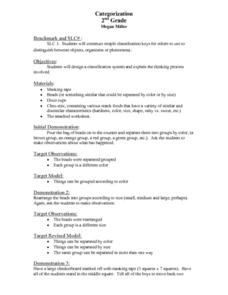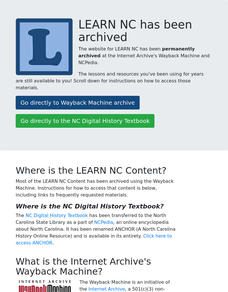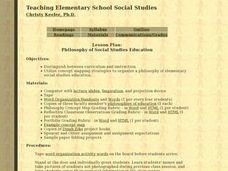Curated OER
Bud, Not Buddy: List-Group-Label Vocabulary Strategy
Readers of Bud, Not Buddy demonstrate their knowledge of the Great Depression with a list, group, label vocabulary strategy. Included are complete directions for the activity that will also introduce class members to the new vocabulary...
Curated OER
The Five Senses - Observation, Experimentation, Prediction, and Categorization.
First graders engage in this creative and well-designed activity. They rotate through five learning stations, each devoted to one of the senses. They practice observation, experimentation, prediction, and categorization.
Curated OER
Animals
Pupils demonstrate and understanding of animal coverings and types of movement through drawings, making of booklets and categorization activities.
Curated OER
What Does Not Belong?
In these critical thinking worksheets, students study the 4 pictures in each set and circle or cross out the picture that does not belong. Students complete 10 activities.
Curated OER
The Grouchy Ladybug By Eric Carle
Second graders complete a unit about ladybugs based on Eric Carle's, The Grouchy Ladybug. They complete comprehension questions, categorization activities, Venn diagrams, and choral readings of Susan M. Paprocki', Little Red Bug. As they...
Virginia Department of Education
Classification of Organisms
Searching for the perfect indoor/outdoor activity that allows class members the opportunity to learn about organism classification? Here, pupils research organisms and categorize them according to domain and kingdom over the course...
Discovery Education
Clutter Cutter
Challenge young learners to cut the clutter with this fun engineering project. As employees of a home and office supply company, young engineers are asked to develop devices that organize everyday items. After participating in a...
Curated OER
Categorization
Second graders participate in a teacher led bead sorting activity in which they describe different ways the beads can be grouped. Next, they participate in activities in which they sort and resort themselves into groups according to...
Curated OER
Moth or Butterfly
Students categorize butterflies and moths by identifying the unique characteristics of the two different species. In this classifying lesson, students discuss their prior knowledge about these insects before categorizing the...
Curated OER
Finding Your Way in the World Wide Web
Researchers practice grouping items to explore the concept of a database. They apply these concepts to the WWW search engine format and consider why it is important to enter the most specific information.
Curated OER
Daily Oral Language Activities: Idioms
Third graders examine the use of idioms. For this vocabulary and reading lesson, 3rd graders explore what idioms are and make their own idiom cards to help them understand the use idioms in language.
Curated OER
By Any Other Name
Young scholars examine the differences between the definitions of race and ethnicity defined by the United States government. After reading an article, they discuss the possiblity of the elimination of some races from the 2010 census....
Curated OER
Let the Phone Get Them Talking! Using the Yellow Pages as a Teaching Resource
Students categorize information in the Yellow Pages. In this Let the Phone Book Get Them Talking! instructional activity, students find pictures in the Yellow Pages and thus gain a better understanding of how the book is organized....
Curated OER
Pets
Students select pets from available graphics to represent pets they own. They categorize the pets according to those that live inside the home, pets that live outside and a pet they would like to own. They generate sentences about each.
Facing History and Ourselves
How Do Communities Define We and They?
Learners consider the categorization of people. For this community identity instructional activity, 6th graders examine community membership definitions and consider how those outside of the group view themselves. Learners analyze The...
Curated OER
The Future of Social Studies Education
Students work in groups of four and complete a roster of their names and personal information and to complete a release form that allows their pictures to be placed online. They then engage in classroom activities while being...
Curated OER
The Spirit of Islam
Students do six different lessons that have many activities which help them to gain an understanding of Islam and Muslim people and how people must work together to combat stereotyping.
Novelinks
The Devil’s Arithmetic: Semantic Feature Analysis
Organize the characters in Jane Yolen's The Devil's Arithmetic according to their shared character traits. After listing character traits as a class, kids note which characters exhibit particular characteristics with a...
Curated OER
Outlining for Beginners
Students examine the standard form of an outline by viewing several examples. They practice categorizing information and then create a simple outline.
Curated OER
Going On A Picnic
Students classify items you would bring on a picnic into different categories. In this sorting lesson plan, students have categories of food, table things, and toys. A simple instructional activity that teaches an important skill.
West Contra Costa Unified School District
Talking About Distance, Rate and Time
Connect the tortoise and the hare fable to mathematics. Learners first identify key terms related to distance, rate, and time. They then solve distance/rate/time problems using different representations.
Curated OER
Philosophy of Social Studies Education
Learn how to distinguish between curriculum and instruction. Utilize concept mapping strategies to organize a philosophy of elementary social studies education. Your class will be able to explain the process they underwent to organize...
Curated OER
Touch and Discover
Students work together to identify and categorize objects. They have to identify the object on touch because they are blindfolded. They record their data and describe the objects once they can look at them.
Curated OER
Freak the Mighty: Chapter 18 Semantic Feature Analysis
Intelligent? Arrogant? Obnoxious? After completing Chapter 18 of Freak the Mighty, individuals fill out a semantic feature chart for characters in Rodman Philbrick's novel. Group members then use their charts to discuss relationships...























